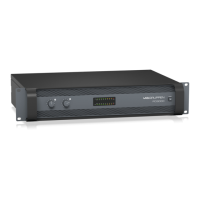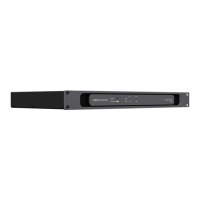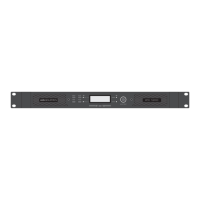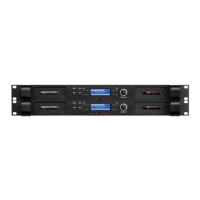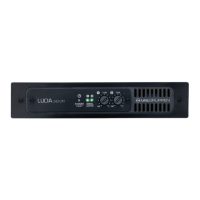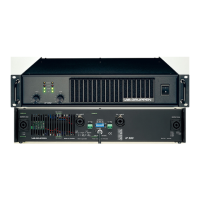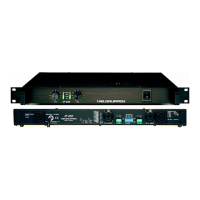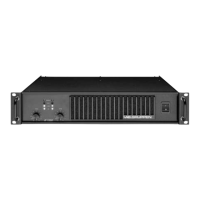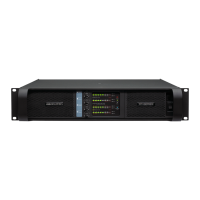26 PDX3000 Quick Start Guide 27
Delay/Peak Limiter
Channel Link
In Dual Mono, Bi-Amp 1, and Bi-Amp 2 modes, the Channel Link virtual button will appear just above the Delay and Peak Limiter controls. When you click on the
Channel Link virtual button, the button will light up, and the Delay and Peak
Limiter controls for both channels will display identical values.
Delay
The Delay function digitally slows the nal signal output from the ampli er by a programmable amount (expressed as either distance or time). This signal delay helps prevent
phase and synchronization problems caused by sound traveling through air over long distances, e.g., between speaker arrays separated by long distances or between a
performance stage and distant sound reinforcement speakers.
The Delay controls also simultaneously display the amount of signal delay in milliseconds (ms), meters (m), and feet (ft), which can be useful if you already know the
precise distance between speakers.
Programming signal delay
1. Program the signal delay by using either of these two methods:
a) Rotate the Delay virtual knob clockwise until you achieve a suitable amount of signal delay. The ms, m, and ft text boxes will each display equivalent values as you
rotate the virtual knob.
b) Type a delay value directly into one of the text boxes below the Delay virtual knob (ms, m, or ft, depending on your preference). The Delay virtual knob will rotate
to a position matching the delay value you have entered.
2. Choose between 0° and 180° phase either by clicking on the Phase virtual button or by clicking directly on 0° or 180° directly below the virtual button. When the
Phase virtual button is engaged, the virtual button will light blue and the indicator next to 180° will light up.
Peak Limiter
The Peak Limiter helps protect your speakers by preventing signal spikes at the ampli er’s output stage.
The Peak Limiter controls include a dedicated virtual knob with matching numerical displays in dBFS (decibels relative to full scale), Vp (Voltage(peak)), as well as a
rating in Watts, which appears only when you choose an Ohm setting from the Load pulldown menu.
The PDX Controller software also allows you to see the ampli er’s total output as a rating in Watts. This Watt rating allows you to connect speakers with lower power
ratings and then adjust the limiter to match the speakers’ maximum Watt rating.
Note: the PDX Controller software does not automatically detect or show the total speaker load connected to the ampli er.
Controls for Hold and Release times appear near the bottom of the window, each with a matching numerical display.
Programming the output limiter
1. Program the output limiter by using either of these two methods:
a) Rotate the Peak Limiter virtual knob counter-clockwise until you find an adequate limiter setting for your sound system. The dBFS (decibels relative to full scale)
and Vp (Voltage [peak]) text boxes will each display equivalent values as you rotate the virtual knob.
b) Type a limiter value directly into one of the text boxes below the Peak Limiter virtual knob (dBFS or Vp). The Peak Limiter virtual knob will rotate to a position
matching the delay value you have entered.
2. Choose a Load value from the Load pulldown menu (none, 2, 4, 8, or 16 Ohms) that matches the total combined load of all speakers connected to the amplifier’s
outputs. If your combined speaker load in Ohms does not exactly match 2, 4, 8, or 16 Ohms, choose the next lower Ohm setting from the Load pulldown menu.
When you select a Load setting, an additional Watt rating for the limiter will appear above the Load pulldown menu.
3. Choose a Hold value either by rotating the Hold virtual knob or by entering a value (in milliseconds) into the matching text box below the knob.
4. Choose a Release value either by rotating the Release virtual knob or by entering a value (in milliseconds) into the matching text box below the knob.
Mode
Changing amplifier mode
The ampli er mode can be changed by clicking on the button for your desired routing option along the left-hand side of the window. When you click on a mode
button, the software will launch a con rmation window. Click “Yes” in the con
rmation window to launch the new ampli er mode, and the new signal path will
appear in the display.
Mode descriptions
Dual Mono
Dual Mono mode routes each channel input, A and B, through completely separate parallel signal paths with independent outputs for each channel. Each channel may
be processed with its own unique lter, equalization, delay, and limiter settings. The Delay and Limit modules for A and B can be linked and programmed with
identical settings by clicking on the Channel Link button below the Mode window.
Stereo
Stereo mode routes the signal from both the A and B inputs through a single series of DSP modules. Each DSP module processes both the A and B signals with identical,
linked settings. The linked Delay and Limit parameters can be controlled from Stereo mode’s consolidated Channel A+B control window (which displays automatically
when Stereo mode is selected).
Bi-Amp 1
Bi-Amp 1 mode splits the Channel A input signal in the XOver DSP module at a programmable frequency point, and then routes the resulting high and low frequency
signals through a parallel chain of DSP modules with independent equalization, delay, and limiter settings. The Delay and Limit modules for the split high and low
frequency signals can be linked and programmed with identical settings by clicking on the Channel Link button below the Mode window. In Bi-Amp 1 mode, Output A
routes low frequencies to a low-range speaker, while Output B connects to a high-frequency transducer.
Bi-Amp 2
Bi-Amp 2 mode operates identically to Bi-Amp 1 mode, except that the signals are swapped between Outputs A and B (i.e., Output B handles low frequencies while
Output A handles high frequencies). The swapped A and B output routing allows the user to quickly correct reversed high/low speaker connections without having to
physically access the ampli er’s back panel and manually change the speaker connection.
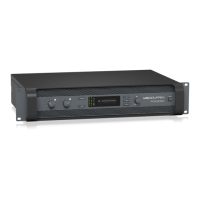
